Technical notes
In the 1780s, François Mols noted that NG2790, though it had at times suffered from neglect, was remarkably well preserved: ‘it is still as fresh as when it came from the artist’s brush.’40 The author of the ‘Description’ of 1788 stated that the panel ‘is as firm, as if just taken from the Hands of the Joiner’.41 At the sale of 1788, the picture was reported to be ‘in perfect preservation’.42 Even the most hostile critics, for example Louis Simond in 1811, conceded that it was ‘in a wonderful state of preservation’.43 In 1884, William Morrill thinned the panel44 and then, presumably, applied the cradle, which, however, does not bear a stamp. In 1918, 1939, 1940–1 and 1957, minor repairs were carried out. In 1974–5 a split in the panel was mended and the painted surface was cleaned. Both the panel and the paint are in excellent condition. There are one or two small damages in the architecture and the sky above the Virgin’s head and in the drapery of the flying angel fifth from the left; there are other small losses along some of the joins in the panel and along the lower edge. In some areas the paint has become slightly transparent and the underdrawing is visible. Some of the yellow-and red-lake pigments have probably faded.45
The panel, which measures 179.8 x 163.2 cm, is made up of six oak boards, laid vertically, vertical in grain and radially cut. The butt joins were reinforced with dowels. The widths of the boards are: at the top edge, 30.25, 28.15, 25.7, 32.3, 25.1 and 21.7 cm; and at the lower edge, 29.2, 28.5, 27.9, 30.2, 25.5 and 21.2 cm. The back has been planed and the thickness varies between 7 and 8 mm; a cradle has been applied which consists of 20 vertical and 16 horizontal members. When the panel was thinned, the dowels were exposed and removed. Only six dowel-holes are now visible but many more must be concealed under the cradle. The panel has a slight convex warp and there is a little woodworm damage at the right edge. There are no labels, inscriptions or other marks on the reverse. No dendrochronological investigation has been attempted.
The painted surface measures approximately 177.2 x 161.8 cm and there are unpainted edges on all four sides. As they vary in width from about 1 cm at the top to about 1 mm at the lower left, they have obviously been trimmed. Along the unpainted edges at the top and bottom are irregularly-spaced holes, countersunk on the obverse (16 along the top edge, 17 along the lower edge); in some places small areas of paint and ground have been lost because of the countersinking. These holes were presumably drilled in order to secure the panel into a frame. The unpainted edges imply that the ground was applied when a framing structure was in place. In some areas there are ‘barbes’, indicating that ground and paint were applied while the panel was framed, but in other areas, for example the head of the attendant on the extreme right, original paint extends beyond the ground onto the bare wood of the unpainted edges.
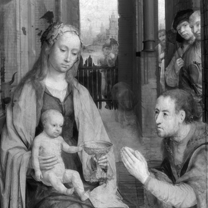
View enlargement in Image Viewer
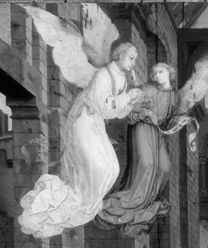
View enlargement in Image Viewer
The ground is chalk in animal glue and is covered by a thin priming layer of lead white mixed with a little lead-tin yellow. Infrared reflectograms46 reveal considerable amounts of underdrawing, which appears to be in a liquid medium and which is applied on top of the priming, and a great many changes (see below) made at all stages of the drawing and painting processes.47 The main lines of the architecture are ruled but the rest of the drawing is freehand. There are no indications that any mechanical methods of transfer have been used. The drawing is detailed, with areas of diagonal hatching to indicate shadowed areas in the draperies and with curving lines as well as diagonal hatching to suggest shadows in flesh areas (figs.10, 11). Often, for example in Caspar’s nose, the artist has drawn several lines in his search for the definitive contour (fig.10). Details such as knuckles and fingernails are drawn: the knuckles of the youth on the extreme left, for example, are indicated in a summary way by a series of rapidly underdrawn arcs; wrinkles in the hose of Melchior and his attendants are underdrawn; and decorative elements such as the pattern on Balthasar’s robe have underdrawn outlines (fig.14). Many adjustments have been made to the contours during painting: for example in the foremost three angels and their wings (fig.11); and the dog in the lower-right corner.
The Virgin once wore a chemise with a higher neck, which was painted, but, in a complex series of alterations, Gossart has changed it for the front-opening chemise that is now visible.48 The Child’s head was at first underdrawn, inclined towards Caspar’s gift. It was then redrawn and a reserve left to the right of its present position, which is the result of a final adjustment in paint of its place and scale. At first, the Child did not hold a coin but touched the edge of Caspar’s goblet; the goblet itself, with the Virgin’s left hand and mantle, has been altered more than once (fig.10). The fall of the Virgin’s draperies across the broken floor has also been changed as painting progressed and probably after Gossart decided to include Caspar’s sceptre (fig.16). The attendant on Melchior’s right is underdrawn with half-closed eyes but painted with wide-open eyes. The group of attendants behind Melchior is much altered (fig.14). The head of the attendant immediately behind Balthasar is painted on top of an underdrawing and a reserve for a different head in a different position: a man with a very broad nose facing towards our right (fig.12). The top parts of the turban of Balthasar’s black attendant and of Balthasar’s crown have been painted over the largely-finished walls of the building behind them; and the inscribed ends of Balthasar’s scarf with its fringes have been added at a late stage in the course of painting.
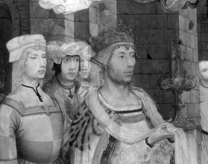
View enlargement in Image Viewer
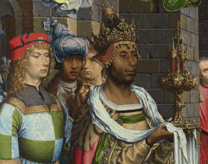
View enlargement in Image Viewer
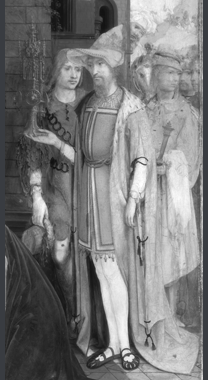
View enlargement in Image Viewer
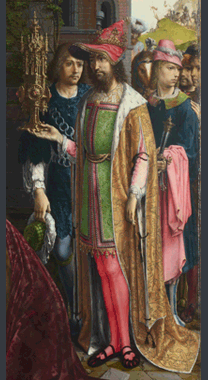
View enlargement in Image Viewer
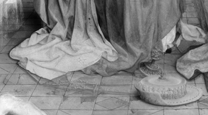
View enlargement in Image Viewer
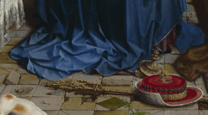
View enlargement in Image Viewer
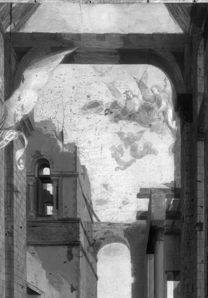
View enlargement in Image Viewer
Almost all the architectural elements were altered after the painting was nearly finished. Both the central arches were painted as broken; they were made entire only at a fairly late stage (fig.18). Certain figures, animals and objects are neither underdrawn nor reserved but have been added at a late stage and are painted directly on top of whatever is behind them. These include: the two figures at the window on our left; the two shepherds behind the ass and the two shepherds in the distance, immediately on our right of them (fig.10); the ox; the ass; Joseph’s stick; the sash of the angel in the upper left corner (fig.11); Caspar’s sceptre; the lid of his goblet and the stone supporting it (fig.16). The broken tiles of the floor and the plants in the foreground were all added after the grid of the floor, itself laid out only after the main figures had been blocked in.
The underdrawing and all the changes appear to be the work of one artist, Jean Gossart; there are no obvious interventions by assistants.
Natural ultramarine occurs in the Virgin's robes; different grades of azurite and red lakes that differ in hue have been used; the haloes of the Virgin and Child are painted in shell-gold. Lead-tin yellow and yellow earth have been mixed into the flesh paint of the heads of the man on the extreme right and the angel in green in the upper-left corner – and probably also the heads of the Virgin, the foremost shepherd and other protagonists. The medium is linseed oil; some resin, probably pine-resin, has been detected in a sample from the red glaze on the crimson edge of an angel's wing. There is no evidence that the oil has been heat-bodied.49
In order to extend his range of colour and tone, Gossart has mixed and layered his pigments in unusually complex ways.50 Some of his blues, greens and reds are undermodelled in different tones of grey (lead white and black). The Virgin’s dress, for example, is undermodelled in grey beneath the blue, whereas her mantle, of a different, more intense blue, is not over grey (figs.19, 10). The green robe of the angel second from our left is undermodelled in grey. The green layer on top, which is mainly of verdigris, is thicker in the shadows, while in the lighter areas the verdigris is mixed with small amounts of lead-tin yellow and lead white. This contrasts with the green drapery of the small angel behind the ox, where the grey undermodelling lies under a thinner, more translucent layer of verdigris and the modelling is all in the grey underpaint. Caspar’s robe is underpainted in a uniform, very dark grey, over which is a modelling layer of mixtures of red lake and lead white. The darker red pattern is rendered in red lake and the whole mantle has received a final glaze of the same red lake. The dyestuff from which this red lake is derived is probably from a scale insect source, perhaps the kermes insect. Different mixtures of red and blue are used to create various shades of purple: from the pale mauve of Balthasar’s sash (red lake, azurite and lead white) to the deeper purple of the Virgin’s underdress (ultramarine and red lake).

View enlargement in Image Viewer
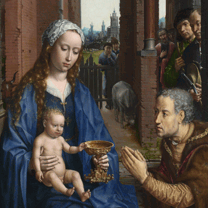
View enlargement in Image Viewer
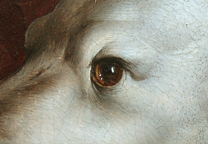
View enlargement in Image Viewer
The hair and beards are often rendered using ‘sgraffito’, for example the beards of Balthasar and the horseman on the right and the hair of the attendant on the extreme right. In certain places, for instance the green areas of the doublet of the attendant on the left, the glazes are spotted, because they have been blotted with cloths. A fingerprint in the green glaze on the robe of the angel behind the ox spreads onto the bricks on our right and shows that Gossart has blotted the glaze with his finger. In the head of the attendant directly behind Balthasar, the parts painted over the reserve for a different head are rather thin, whereas the parts painted over the architecture are thicker and contain much more lead white. The transitions are not at all obtrusive. On occasion, the paint is impasted to cast real shadows that play some part in creating illusions of form. Frequently the paint is worked wet-in-wet, for example in the eye of the dog in the lower-right corner (fig.20); the wet paint is often dragged or feathered, for example in Melchior’s ermine and in the fur of the shepherd holding the pipe.
Especially in the foreground, there are virtuoso passages of detail: for instance the hairs sprouting from the wart on Caspar’s cheek (fig.21), the decoration of Caspar’s hat and the fringes on Balthasar’s stole (fig.4). From each of the pearls on Melchior’s hat protrudes a tiny yellow spot to indicate the golden pin that holds it in place (fig.22). By contrast, some extraordinary details are rendered with surprising economy of effort. The pearls edging Melchior’s doublet are strips of grey, worked over quickly with white highlights, pale blue secondary lights and dark grey shadows that define the shapes of the pearls (fig.23). The pearls on Caspar’s hat, however, which are more readily visible, are more carefully executed. They are roundels of grey, painted on top of the red of the hat and thin enough to reveal the red in some places, as if it were reflected in the pearls. On the shadow sides are black crescents and bright orange reflected lights, while on the lit sides are tall dashes of azurite and white and, on top of that, dots of pure white (fig.24).
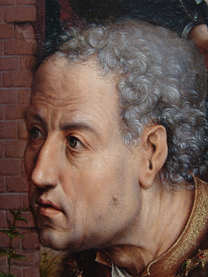
View enlargement in Image Viewer
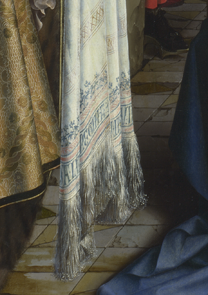
View enlargement in Image Viewer
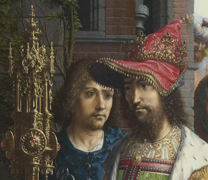
View enlargement in Image Viewer
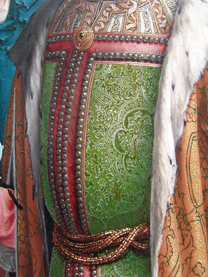
View enlargement in Image Viewer
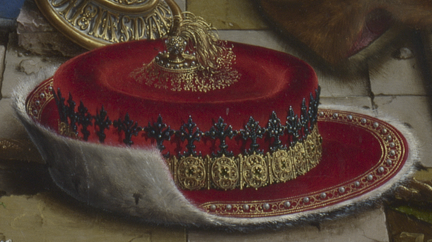
View enlargement in Image Viewer
